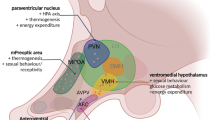Abstract
The thermogenic response to noradrenaline administra-tion was investigated at 25° in two models of obese mice (genetic ob/ob obesity of the ‘QEC’ strain and monosodium-glutamate-induced obesity) and in their respective lean littermates. Subcutaneous injections of a low dose of noradrenaline (I00 μg/kg body wt.) eJevated metabolic rate by about 3096 in both obese models but not in their respective lean counterparts. In contrast, the increase in metabolic rate after injections of a high dose of noradrenaline (600 μg/kg body wt.) was of a similar magnitude in both lean and obese animals: metabolic rate was increased by 70–80%. These results indicate that the overall whole body thermogenic capacity is unimpaired at room temperature in this ‘QEC’ strain of ob/ob mice and in the hypothalamic damaged obese mice. Obesity in these models is therefore not associated with a reduced ability to respond to noradrenaline but could rather be due to a failure to release noradrenaline.
Similar content being viewed by others
References
Arch JRS (1983) Defective thermoregulatory thermogenesis in genetically obese (ob/ob) mice is not due to insensitivity to noradrenaline. In: Environment, Drugs and Thermoregulation (Lomax P, ed), pp 35–39, Karger, Basel, Switzerland.
Arch JRS, Ainsworth AT & Cawthorne MA (1982) Thermogenic and anorectic effects of ephedrine and congeners in mice and rats. Life Sci.30, 1817–1826.
Boroumand M (1977) Nutrition and genetics: A study of obesity and leanness in the rat. PhD thesis, London University.
Bray GA & York DA (1979) Hypothalamic and genetic obesity in experimental animals: An autonomic and endocrine hypothesis. Physiol. Rev.59, 719–809.
Davis TRA & Mayer J (1954) Imperfect homeothermia in the hereditary obese-hyperglycaemic syndrome of mice. Am. J. Physiol.177, 222–226.
Djazayery A, Miller DS & Stock MJ (1979) Energy balances in obese mice. Nutr. Metab.23, 357–367.
Dulloo AG (1982) The regulation of energy balance by the sympathetic nervous system: A study of thermogenic drugs in lean and obese rodents. PhD thesis, London University.
Herburg L & Coleman A (1977) Laboratory animals exhibiting obesity and diabetes syndromes. Metabolism26, 56–99.
Himms-Hagen J (1976) Cellular thermogenesis. Ann. Rev. Physiol.38, 315–351.
Hogan S, Himms-Hagen J (1980) Abnormal brown adipose tissue in obese (ob/ob) mice: response to acclimation to cold. Am. J. Physiol.239, E301-E309.
Hogan S & Himms-Hagen J (1983) Brown adipose tissue of mice with gold thioglucose obesity: effect of cold and diet. Am. J. Physiol.244, E581–588.
Knehans AW & Romsos DR (1983) Norepinephrine turnover in obese ob/ob mice: effects of age, fasting, and acute cold. Am. J. Physiol.244, E567-E574.
Macdonald IA, Stock MJ (1979) Influence of norepinephrine and fasting on the oxygen consumption of genetically obese mice. Nutr. Metab.23, 250–255.
Massoudi M, Evans E & Miller DS (1983) Thermogenic drugs for the treatment of obesity: screening using obese rats and mice. Nutr. Metab.27, 26–37.
Miller DS (1979) Non-genetic models of obesity. In: Animal Models of Obesity (Festing MFW, ed), pp 131–140, Macmillan, London.
Rothwell NJ, Saville ME & Stock MJ (1981) Thermogenic responses to food, noradrenaline and triiodothyronine in lean and obese Zucker rats. J. Physiol.319, 53P-54P.
Rothwell NJ & Stock MJ (1979) A role for brown adipose tissue in diet-induced thermogenesis. Nature281, 31–35.
Rothwell NJ & Stock MJ (1980) Similarities between cold- and diet-induced thermogenesis in the rat. Can. J. Physiol. Pharmacol.58, 842–848.
Stirling JL & Stock MJ (1968) Metabolic origins of thermogenesis induced by diet. Nature220, 801–802.
Trayhurn P & James WPT (1978) Thermoregulation and non-shivering thermogenesis in the genetically obese (ob/ob) mouse. Pflügers Arch.373, 189–193.
Vander Tuig JG, Knehans AW & Romsos DR (1982) Reduced sympathetic nervous system activity in rats with ventromedial hypothalamic lesions. Life Sci.30, 913–920.
Author information
Authors and Affiliations
Rights and permissions
About this article
Cite this article
Duloo, A.G., Miller, D.S. Unimpaired thermogenic response to noradrenaline in genetic (ob/ob) and hypothalamic (MSG) obese mice. Biosci Rep 4, 343–349 (1984). https://doi.org/10.1007/BF01140498
Received:
Issue Date:
DOI: https://doi.org/10.1007/BF01140498




